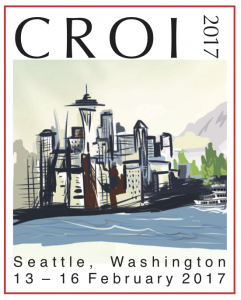Pre-ART drug resistance in rural South Africa but limited clinical impact with good adherence
24 April 2017. Related: Conference reports, Antiretrovirals, Drug resistance, CROI 24 (Retrovirus) 2017.

Polly Clayden, HIV i-Base
Results from the Africa Health Research Institute showed significant pretreatment antiretroviral resistance but this was not associated with reduced viral suppression with good adherence – according to findings from the ANRS 12249 TasP trial presented at CROI 2017.
Greater use of antiretroviral therapy (ART) in Treat All strategies might lead to higher levels of acquired and transmitted drug resistance (DR) and reduce ART efficacy.
The ANRS 12249 two arm cluster-randomised TasP trial was conducted in KwaZulu-Natal to evaluate the effect of early ART, started irrespective of CD4 count on HIV incidence. Participants were randomised to treat all HIV positive people or treat according to South African guidelines (CD4 350 or 500 cells/mm3) at the time of the trial, which took place between 9 March 2012 and 30 June 2016. The study did not show a difference between the two arms.
The second objective of the trial was to look at the prevalence of pre-treatment DR (PDR) and its impact on viral suppression (<400 copies mL) in ART naive participants starting first-line treatment in the trial. Two presentations at CROI 2017 described these findings. [1,2]
There were sequences available from 1337 participants at trial entry: 189 dried blood spot samples (participants diagnosed HIV positive but did not refer to TasP clinic); and plasma samples from 88 recently infected and 1060 chronically infected participants.
Pol gene Sanger sequencing was performed on dried blood spots with detection threshold 20%. Full or partial HIV genome sequencing was performed on plasma samples. Low level variants were called at a 2% level.
The overall prevalence for any PDR in majority virus for all participants was 8.7% (95% CI 7.3 to 10.3). Any PDR prevalence in chronic infection and recent infection at >2% threshold was 16.7% and 21.6% respectively.
PDR was predominantly to NNRTI drug class driven by K103N/S; there were low levels of K65R mutation; PI mutations were very rare.
When the investigators looked at antiretroviral susceptibility, 7% of participants would start ART with high level PDR to NNRTIs and only two fully active drugs out of three. But most participants would be susceptible to tenofovir and FTC.
Among participants with PDR, 74% had only one mutation. But 11% participants had three or more (up to seven) – the investigators noted that this was not observed among newly infected participants – suggesting that this group had previously received ART.
A total of 837 participants starting ART in the trial with follow up viral load results contributed to the evaluation of the impact of PDR on viral suppression: 93.3% received a fixed dose combination of efavirenz/tenofovir/FTC.
Participants were a median of 34 years of age at baseline with over one third aged 16-29; the majority (71.6%) were female and about half were eligible for ART according to South African guidelines. The prevalence of PDR mutations was similar to that observed in those starting ART overall (16.5%).
The median time to viral suppression (<50 copies/mL) was 3.61 months (IQR 3.19 to 3.71). The median time on ART was 1.36 years (IQR 0.91 to 2.13). Cumulative probability of suppression at 12 months was 94.5% (95% CI 92.7 to 96.0). Kaplan-Meier estimates showed no difference in viral suppression with or without DR at baseline.
In multivariate analysis adjusted for sex, age, baseline viral and adherence, high baseline viral load (>100,000 vs <10,000 copies/mL) was associated with a decreased rate of viral suppression: RR 0.48 (95% CI 0.39 to 0.59), p<0.0001. Good adherence (>95% vs <95%) was associated with an increased rate of viral suppression: RR 1.29 (95% CI 1.04 to 1.60), p=0.017.
Comment
The prevalence of transmitted drug resistance is above the WHO threshold of 5% in this study conducted in rural South Africa. The investigators suggest that this might be overcome with optimal adherence. This study only has 16 months of follow up and longer-term outcomes are needed to confirm these findings.
References:
- Derache A et al. Prevalence and impact of pretreatment drug resistance in the ANRS 12249 TasP trial. CROI 2017. 13-16. Seattle, Washington. Oral abstract 43.
http://www.croiconference.org/sessions/prevalence-and-impact-pretreatment-drug-resistance-anrs-12249-tasp-trial (abstract)
http://www.croiwebcasts.org/p/2017croi/croi33380 (webcast) - Iwuji CC et al. Response to first-line art in adults with drug resistant HIV, ANRS 12249 TasP trial. CROI 2017. 13-16. Seattle, Washington. Poster abstract 491.
http://www.croiconference.org/sessions/response-first-line-art-adults-drug-resistant-hiv-anrs-12249-tasp-trial (abstract)
http://www.croiconference.org/sites/default/files/posters-2017/491_Iwuji.pdf (poster)

